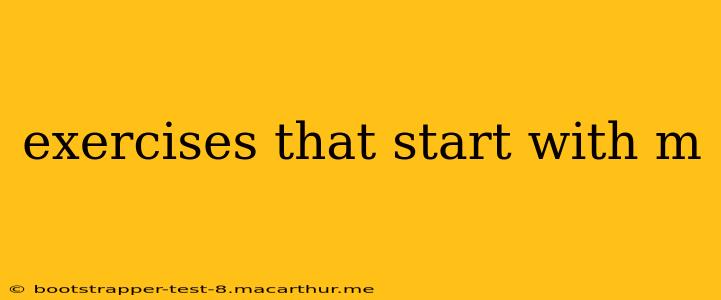Finding the perfect workout routine can be a challenge. Many people search for exercises based on the body part they want to target, or the equipment they have available. Sometimes, however, the search is a little more… whimsical. If you're looking for exercises that start with the letter "M," you've come to the right place! This guide explores a range of movements, covering different fitness levels and goals. We'll delve into the muscles worked, the benefits, and proper form to ensure you get the most out of your workout and avoid injury.
Common Exercises Starting With "M"
This section will cover some of the most popular exercises that begin with the letter M, categorizing them for clarity and providing detailed explanations.
1. Mountain Climbers
Muscles Worked: Primarily targets core muscles (rectus abdominis, obliques, transverse abdominis), but also engages shoulders, chest, and legs (quadriceps, hamstrings, glutes).
Benefits: Improves cardiovascular health, strengthens core muscles, increases flexibility, and enhances overall body coordination.
How to: Start in a high plank position with hands shoulder-width apart and body forming a straight line. Bring one knee towards your chest, then quickly return to the starting position and repeat with the other leg. Continue alternating legs in a running motion.
2. Military Press (Overhead Press)
Muscles Worked: Primarily targets the shoulders (deltoids – anterior, medial, and posterior), but also engages the triceps and upper back muscles (trapezius).
Benefits: Builds shoulder strength and stability, improves upper body power, and enhances overall athletic performance.
How to: Stand with feet shoulder-width apart, holding dumbbells or a barbell at shoulder height. Keeping your core engaged, press the weight straight overhead until your arms are fully extended. Slowly lower the weight back to the starting position.
3. Modified Push-Ups
Muscles Worked: Primarily targets chest (pectoralis major), shoulders (deltoids), and triceps. Modifications allow for adjustments based on fitness level.
Benefits: Builds upper body strength, improves posture, and enhances muscular endurance.
How to: Perform standard push-ups or modify by performing them on your knees, inclining your body, or widening your hands for greater pectoral activation. Maintain a straight body line from head to heels or knees.
4. Med Ball Slams
Muscles Worked: This explosive movement engages the entire body, with a primary focus on core muscles, shoulders, and legs.
Benefits: Improves cardiovascular fitness, builds explosive power, and strengthens the core.
How to: Hold a medicine ball overhead, then slam it forcefully down to the ground. Bend at the knees to catch the ball and repeat.
5. Marching in Place (with High Knees)
Muscles Worked: This primarily engages the hip flexors and quadriceps, with secondary activation of core muscles.
Benefits: Excellent for a warm-up or light cardio exercise, improving mobility and blood flow in the legs.
How To: Stand tall with good posture. Bring your knees up high towards your chest, alternating legs in a marching motion. Maintain a good pace.
Frequently Asked Questions (FAQs)
What are some more advanced exercises starting with "M"?
Many more advanced exercises exist, depending on your training level and the equipment you have access to. These might include moves like Muscle-ups (gymnastics), various variations of the Military Press (using heavier weights or different stances), or complex movements incorporating multiple "M" exercises into a single flow. Always consult a certified trainer before attempting advanced exercises.
Are these exercises suitable for beginners?
Many of the exercises listed above, particularly modified versions, are suitable for beginners. Starting with low repetitions and focusing on proper form is crucial. Always listen to your body and stop if you feel any pain. Consider consulting a fitness professional to create a personalized plan.
How often should I do these exercises?
The frequency of these exercises depends on your fitness goals and overall training program. Aim for a balanced routine that includes both strength training and cardiovascular exercises, incorporating rest days for muscle recovery. A good starting point might be 2-3 sessions per week, focusing on proper form and gradual progression.
This detailed guide provides a strong foundation for incorporating "M" exercises into your workout routine. Remember to prioritize proper form and listen to your body to maximize results and minimize the risk of injury. Always consult with a healthcare professional or certified personal trainer before starting any new exercise program.
